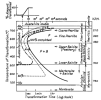- Joined
- Dec 27, 2019
- Messages
- 33
What is the exact reason for pre-heating the AAA quench oil from Dubois. The P50 or parks 50 is fine to be run at room temp. The AAA oil lists ideal temp range to be 130-160f. It also lists it to be used from 77-180f. Warming canola from what I gather was always to make it thinner and speed up its cooling ability. Test coupons for medium hardenability steels like 5160, 6150, 4140, 80crv2 have fully hardened and test the same rockwell in room temperature AAA and P50. So is the warming it up to 130f to get it to match it's medium to fast quench speed or is it to possibly slow the lower end temperature as the steel goes through the martensite finishing temperature to negate added stress kind of like marquenching? Or is it to homogenize the oil somehow and make it more consistent? Recently I hardened a whole bunch of 6150 punches and chisels and some larger items and the oil got to the upper limit of it's temperature and instead of letting the tools cool fully down in the oil I was placing them in a bath of soapy water. The last couple were a bit too hot and the stress from that last bit of cooling in the water cracked them up pretty good. So the last bit of cooling is obviously very important as p50 didn't do this to them and I know that getting the curve in a clay backed blade is dependent on that fast drop at the end that water can bring. I have 5 gallons and to quench small things I don't want to heat the whole thing up if it doesn't need it but if there is a good reason to then I will. Perhaps running some steels in it that balance on the edge of fast or medium would need it to be warmed up but it seems like p50 works fine for those anyway.


